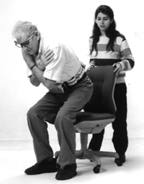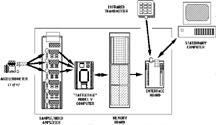1994 Project Reports | Contents | Previous | Next | Home |
Accelerometry for Balance Assessment
Eric E Sabelman, PhD; James Gadd, MS; Denise Chesney, MS; Paul Merritt, MS; Carol Winograd, MD; Deborah Kinney, MS, OTR; Betty Troy, MS; Sandy Dunn Gabrielli
Problem - Falls due to impaired balance present a serious health hazard to elderly as well as to post-surgical and partially-disabled ambulatory persons. Balance, as well as hearing and vision, decline with age (or injury), and each year one-third of the elderly living at home will fall. Approximately 1 in 40 of these persons will be hospitalized as a consequence of the fall. Impaired mobility due to balance deficits or a fear of falling can diminish a person's ability to perform activities of daily living (ADL), and often makes the difference between living independently at home or being supervised in a nursing home facility.
Background - Traditionally, clinical balance assessment is performed by an Occupational or Physical Therapist using subjective, qualitative testing. Balance test results depend highly on clinicians' testing techniques, past experience, and the theoretical model they use for testing. Two quantitative means commercially available are video motion analysis and force plates. Unfortunately, these techniques cannot duplicate all of the factors that may lead to a fall, require that patients come to the laboratory, use considerable floor space in the clinic, and are very expensive (typically $100,000 per instrument, or $360 per test).
Approach - To overcome these disadvantages, we are developing a small, wearable instrument that gathers balance information from the accelerations of a person's head and torso. The current system weighs approximately 2 pounds (Figure 1). Control of the computer is via an infrared (IR) remote control for ease of movement. Data is transferred to an IBM PC compatible computer to manipulate and display the gathered data (Figure 2).

Figure 1. Using accelerometric motion analysis on a subject rising from a chair. |

Figure 2. Data flow for the wearable recorder/computer. |
Methodology and results - In general, studies are performed on both elderly (over age 65) and young (under age 45) populations with no history of falling. Motion tasks in this study included tandem walking (toe-to-heel), quiet standing with eyes both open and closed, walking up and down three steps, and rising from and sitting in a chair (Figure 1).
Study #1 - 30 subjects (25 older females and 5 younger females) were monitored with both accelerometry and video motion analysis.
Results - The accelerometric system produced similar results to the video system, and the magnitude of the differences between head and body vertical acceleration peaks were higher for the older group when ascending/ descending stairs (possibly due to stiffening of intervertebral discs).
Study #2 - 28 subjects (9 older women, 9 older men, 5 younger women, 5 younger men) wearing an improved accelerometric system were evaluated using standardized motion tasks administered by an experienced therapist with simultaneous video imaging. The number of motion tasks was increased from 20 to a total of 65 in 8 categories.
Results - Interpretation of the accelerometric data yielded the same clinical scores as the qualitative assessments in a blind test, as well as information that was not observed easily by therapists. In addition, the accelerometers measured left/right step time symmetry more accurately than the experienced therapist.
Study #3 - 22 subjects (7 older females, 6 older males, 4 younger females, 5 younger males) wore the accelerometric system while undergoing a standard EquiTest protocol on a sliding/tilting force plate.
Results - Accelerometry can duplicate the EquiTest results and also record head movements before measurable shift of the body's center of mass.
Future work - One major objective of this project is to provide real-time quantitative body motion analysis in the same environments and situations in which people actually fall. To achieve this, we are increasing the speed and software capabilities of the computer hardware so that it can perform the calculations necessary to analyze motion patterns in real-time, and respond with sound alarms when appropriate. Other uses for the equipment will be investigated, such as sports training and the prevention and rehabilitation of occupational injuries.
Republished from the 1994 Rehabilitation R&D Center Progress Report. For
current information about this project, contact
Eric Sabelman.